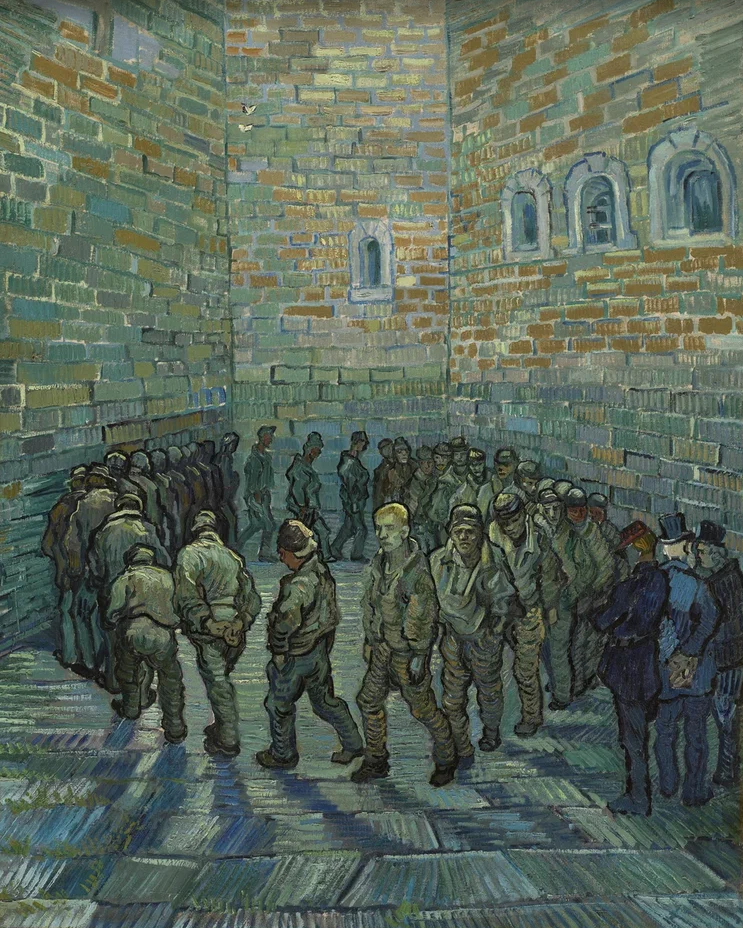Vincent van Gogh. The Prison Courtyard. 1890.

Vincent van Gogh painted The Prison Courtyard in 1890, inspired by an engraving by French illustrator Gustave Doré. In February 1890, Van Gogh was staying at the Saint-Paul-de-Mausole asylum, where he had no opportunity to paint from life. The subject of the work touches upon several legal themes. The first of these is the great judicial reform of King Henry II of England.
Like Doré, Van Gogh depicted prisoners in the courtyard of Newgate Prison, the first detention facility built in accordance with the provisions of the Assize of Clarendon (1166)—a royal act sealed with the Great Seal of England. This document became one of the cornerstones of judicial reform and significantly influenced the development of English common law. The core of Henry II’s reform was the establishment of a system of traveling royal courts, which were dispatched to counties to administer justice in the King’s name for cases of theft, robbery, and murder. Henry II also ordered the construction of prisons in every English county to hold suspects in crimes until the arrival of the royal court.
According to medieval statutes, these institutions were to be managed by two annually elected sheriffs, who then transferred prison administration to private jailers or wardens paying a fixed fee for the privilege. These wardens, in turn, were permitted to charge inmates fees, making the position one of London's most lucrative. The guards—whose income partly depended on charges—collected payments from prisoners for food, bedding, and removal of shackles.
This system remained largely unchanged until the Gaols Act of 1823 attempted to reform and standardize the penitentiary system previously maintained by local county authorities. The Gaols Act of 1823 prohibited the collection of fees from prisoners and established state responsibility for compensating jailers, marking a significant shift toward centralized prison administration.
When examining Van Gogh's painting, one can notice a pair of butterflies fluttering against the prison wall. For the artist, they may have symbolized hope for liberation. With the evolution of legal thought in the late 18th century—spearheaded by John Howard and Jeremy Bentham—a model of criminal punishment was introduced. This system emphasized vocational training, labor, and moral rehabilitation of prisoners as means of reform. Thus, the depiction of butterflies might also serve as a metaphor for human transformation: the potential for personal redemption and the conversion of criminals into law-abiding citizens.
The Prisons (Scotland) Act of 1877 transferred complete control over England's penitentiary system to the Prison Commission, stripping local magistrates of their authority over local jails. Later, in the 1890s, a government committee report on England's penal system concluded that imprisonment should serve as punishment oriented toward rehabilitation—a principle enshrined in the Prisons Act 1898.
Another legal aspect reflected in the painting is the then-prevalent method of the identification of a criminal: detectives had to memorize each convict's face. This was the purpose behind organizing "prisoner parades." In the second half of the 19th century, Scotland Yard's director Howard Vincent began sending inspectors to prisons several times a week to study and memorize the faces of incarcerated criminals. This method of recognizing repeat offenders helped identify prisoners wanted for other crimes. Although photography existed at the time the painting was created, its use in criminal investigations was sporadic and unstandardized: in the mid-19th century, prisoners were photographed only in select prisons in Denmark and Switzerland. Another well-known identification method, Bertillonage, was proposed by Paris police prefect Alphonse Bertillon. This system involved 14 anthropometric measurements to determine a person's identity based on physical data. Though introduced only in 1890, it was short-lived.
When painting this work, Van Gogh primarily used blue paint. The artist was known for his fondness for cool blue, which he combined with warm yellow to convey his inner state. The clash of these two colors also symbolizes the inner conflict that marked Van Gogh’s life—between hope and despair, joy and sorrow. The artist often used blue for his self-portraits. Through blue and its many shades, he sought to understand himself as a person and as an individual.